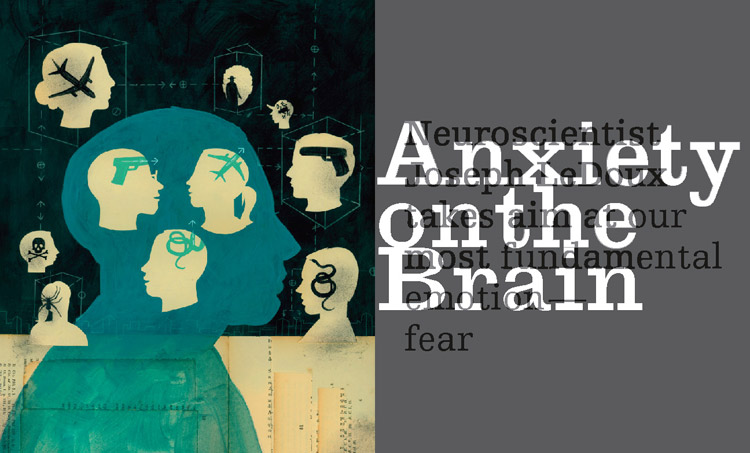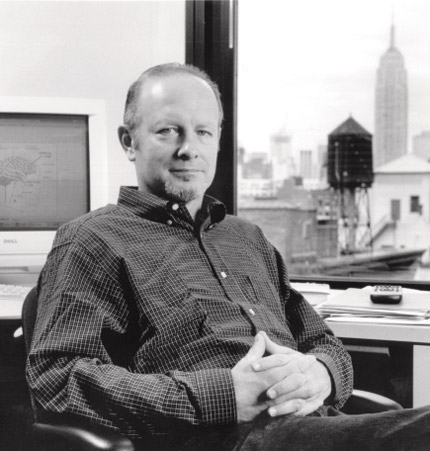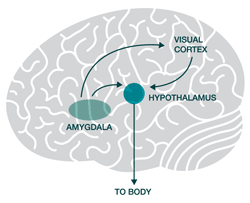
By Carlin Flora
In the 2004 film Eternal Sunshine of the Spotless Mind, Jim Carrey's character, Joel Barish, undergoes a medical procedure to erase some aching memories after a breakup with his girlfriend. Though the scenario intrigued many—the movie won an Oscar for Best Original Screenplay—most assumed it was merely the stuff of cinematic fantasy. But director Michel Gondry acknowledges the story was inspired, in part, by neuroscientist Joseph E. LeDoux's 2000 paper on the prospect of memory erasure for those with post-traumatic stress disorder. And while LeDoux's real world progress is still far behind the film's fictional technology, his therapeutic goals are no less ambitious.

LeDoux has become a crusader for alleviating all sorts of anxieties, a scientist who aims to literally transform the mood of the American public. Author of the acclaimed books, The Emotional Brain (Simon & Schuster) and Synaptic Self: How Our Brains Become Who We Are (Viking), LeDoux says a "tyranny of anxiety" now wreaks havoc on our society, with more than 40 million people in the United States suffering from disorders at an economic cost of $50 billion per year. And with 24-hour TV news channels and Internet sites barraging us with a daily dose of panic and high drama, the national level of fear is only expected to rise. But LeDoux, the Henry and Lucy Moses Professor of Science and winner of the Fyssen Foundation's 2005 International Prize for his work on the neural basis of emotion, believes he's close to understanding how to prevent and treat fear-based disorders, which are affected by our experiences and genetic influences. "Anxiety is the low-hanging fruit of psychiatry," he says. Unlike depression or schizophrenia, which, he notes, are far more complex, LeDoux claims that fear is "a problem that could be solved with a focused research effort."
This mission to move fear off of the emotional forefront is the focus of NYU's new Emotional Brain Institute, founded in 2007, which LeDoux heads, as well as the university's Center for the Neuroscience of Fear and Anxiety, which he directs, and which is funded by the National Institute of Mental Health and includes research teams from Rockefeller University, the Mount Sinai School of Medicine, Weill Medical College of Cornell University, and Columbia University College of Physicians and Surgeons. He's also working with Harold S. Koplewicz, chairman of the department of child and adolescent psychiatry at NYU Medical Center, on a long-term plan to study the development of fear and anxiety in animals and children. One application of this research already under way is an effort to teach stress reduction and emotion regulation skills to kindergartners in New York City public schools. LeDoux insists that controlling fear early is the key to producing well-adjusted adults. "We're not going to eliminate fear—it's always going to be waiting for another trigger," he cautions. "But we can develop strategies to overcome it."
As a kid in the small Cajun town of Eunice, Louisiana, LeDoux, a good-but-not-great student, never pursued scientific hobbies or considered research as a career. But he did get some early anatomy lessons in his father's butcher shop. "Since I was 8 or 9, my job was to take the bullets out of the cow brains," he says. "I used to think about what had been going through the cow's mind when…bam!"
LeDoux moved to the (relatively) big city of Baton Rouge to go to college at Louisiana State University, where he majored in business and went on to get a master's degree in marketing. Inspired by Ralph Nader, he intended to enter the field of consumer protection. But in the final year of his graduate program, he took a course with a professor who was interested in memory formation. "I had no idea you could study the brain," LeDoux remembers. He worked in the professor's lab, published a few papers, and after applying to 12 PhD psychology programs, just barely got accepted to the State University of New York at Stony Brook, where his LSU professor had a friend. It was a passing comment by his mentor at Stony Brook, Michael S. Gazzaniga, that led LeDoux on a decades-long quest: "Michael happened to say to me one day, 'Gee, there's not much research on emotion out there.'"
Coming from a cognitive science background, LeDoux wanted to understand emotion as information processing rather than as subjective feeling—to know why we choose emotions instead of simply how we experience them. At that time, emotion was assumed to be a function of the limbic system, which includes the amygdala, a small almond-shaped structure in the brain's temporal lobe. But attached to the theory as scientists were, no one had honed in on the fact that there was no clear evidence linking emotion to most other limbic areas besides the amygdala. LeDoux began conducting simple fear-conditioning experiments in rats (pairing a tone with a mild shock, for example) to map out the effects of emotional stimuli on the brain and, in the process, discovered that the amygdala itself is the brain's virtual seat of fear. "What I found exhilarating was how [Joe] launched into a new field alone," says Gazzaniga, currently a professor of psychology at the University of California, Santa Barbara. "His training with me was in testing patients, so he had to go back and learn basic neuroscience, learn how to make lesions in the brain. It was like getting another PhD."
 When triggered by fearful sounds or sights, the amygdala rapidly signals to our bodies to freeze while the brain processes the threat.
When triggered by fearful sounds or sights, the amygdala rapidly signals to our bodies to freeze while the brain processes the threat.
LeDoux's true eureka moment came after he traced the nerves connecting the rats' auditory sensations to areas in their brain and found that their emotional, rather than rational, responses to fearful stimuli were processed more quickly. Reacting to a scary sound, a rat brain's "low road" of sensory processing, which centers in the amygdala and leads to an emotional response, functioned almost twice as fast as the "high road" of processing, which involves conscious thought. Because the fear system in humans developed so long ago, it's analogous to that of rats, LeDoux says; when we hear a loud noise, we freeze until our brain decodes whether the noise is threatening.
In rats and humans, the fear of threatening stimuli is triggered by emotionally potent memories, which is why the study of memory formation has been key to LeDoux's research. His lab team is working to figure out how to chemically interrupt the consolidation of traumatic memories so they won't have such a debilitating hold over people. So far, the team has been able to erase specific memories in rats by injecting a chemical into their brains, disrupting the protein synthesis that normally occurs when a memory is recalled. "We've had great success in the animal models," LeDoux says, but notes that "the human work is very slow." Because many victims of post-traumatic stress disorder suffer from drug and alcohol addiction, it's difficult to find the necessary substance-free subjects for the study.
In the meantime, LeDoux has found a less conventional method of spreading his understanding of the emotional brain to the masses: music. At Madison Square Garden last May, he led the Amygdaloids—his rock band comprised of fellow NYU scientists—in front of thousands of students and family members after delivering the College of Arts and Science's graduation keynote speech. During one song, from the group's CD titled Heavy Mental, he crooned, "Why do we feel so afraid? Don't have to look very far. It's all in a nut—in your brain."
TOP Illustration by Leigh Wells;
Photo © James Prince Photography 2008
LeDoux says a “tyranny of anxiety” now wreaks havoc on our society, with more than 40 million people in the United States suffering from disorders at an economic cost of $50 billion
per year.







